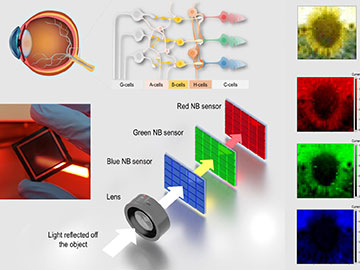Combining three narrowband sensors that detect red, green and blue light with a neuromorphic algorithm mimics the function of the human retina. [Image: K. Wang; CC BY-NC-ND] [Enlarge image]
Scientists at Penn State University, USA, have taken inspiration from the human eye to create a sensor that generates full-color images by capturing and processing red, green and blue light (Sci. Adv., doi: 10.1126/sciadv.ade2338). The bioinspired design avoids the need for an external filter, potentially yielding camera sensors with a higher spatial resolution than existing commercial devices, and could also inform the development of artificial retinas that might one day be used to restore sight.
Imitating the human retina
The device mimics the human retina, which contains cone cells that are sensitive to red, green and blue light, as well as a neural network that preprocesses the visual data before they are transmitted to the brain. Replicating the function of the cone cells required the researchers to create a trio of narrowband detectors that respond only to specific wavelengths of visible light, which they achieved by engineering thin layers of perovskite material using a volatile solvent method.
The highly uniform layers of perovskite produced using this technique exhibit a significant mismatch between the mobility of electrons and holes, an imbalance that can be further manipulated by incorporating the material into a multilayered structure. In this architecture, only the charge carriers generated by specific wavelengths of light are able to reach the electrodes, while modifying the composition of the perovskite allows the fabrication of photodetectors operating in the red, green and blue regimes.
The researchers turned individual photodetectors into 32 × 32 sensor arrays using a laser-scribing technique and then stacked red, green and blue chips on top of each other. This hardware configuration was combined with a neuromorphic algorithm that, like the neural network in the human retina, processes the raw optical signals and generates full-color images. “We tried directly merging the signals from the three-color layers, but the picture was not very clear,” commented lead author Kai Wang. “When we do this neuromorphic processing, the image is much closer to the original.”
The team showed that their bioinspired solution can produce a full-color image with sharp contrast and high fidelity.
No need for filters
The team showed that their bioinspired solution can produce a full-color image with sharp contrast and high fidelity, avoiding the need for filters that discard some of the incoming light before it reaches the sensor and also add complexity and cost to the design. What’s more, the device structure is similar to that used for perovskite solar cells, which the researchers believe could open the door to battery-free camera technology.
Correction, 18 May 2023, 09:35 EDT: This story has been updated to clarify that the electrons and holes are detected at the electrodes, not the light.

